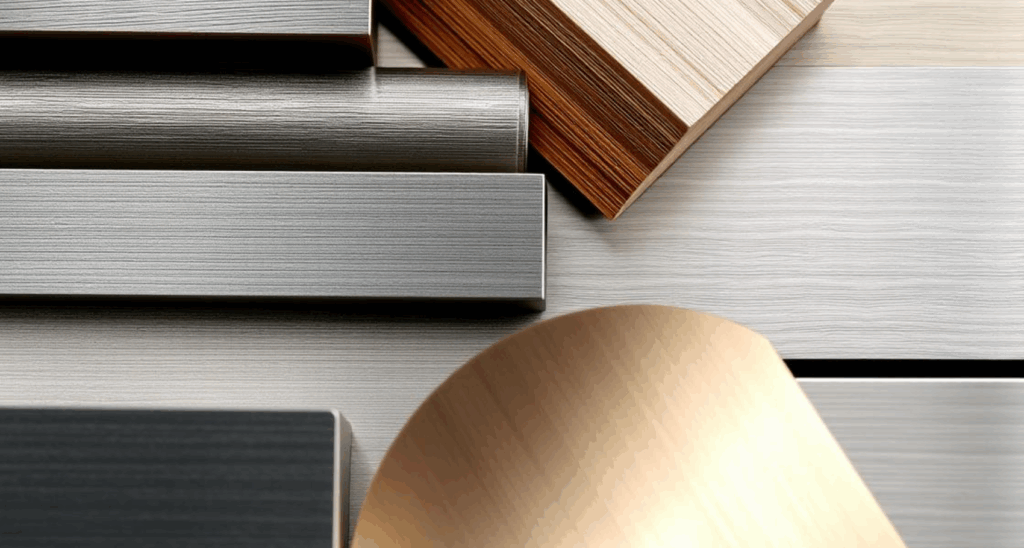Complete analysis of stainless steel surface treatment codes: No.1~No.8, 2B, HL, PVD and other common processing methods and uses

The commonly used codes for stainless steel surface treatment mainly come from ASTM (American Society for Testing and Materials) standards, of which ASTM A480/A480M is the most common classification of stainless steel surface processing. These codes are used to describe the roughness, brightness, finish and treatment of the stainless steel surface. The following are some common codes and their descriptions:
🔩 Stainless steel surface treatment code (ASTM A480 common)
| Surface treatment code | Chinese description | English name | Treatment method and appearance |
|---|---|---|---|
| No. 1 | Hot Rolled, Annealed and Pickled | Rough surface, dull, for industrial use | |
| No. 2D | Cold Rolled, Annealed, Pickled and Skin Passed | Dull surface, suitable for subsequent processing | |
| No. 2B | Polished after cold rolling (most common) | Cold Rolled, Annealed, Pickled and Bright Skin Passed | Smooth surface, soft reflection, most commonly used |
| No. 2BA | Bright annealed | Bright Annealed | High brightness mirror, no further processing required |
| No. 3 | Polished with 100~120 grit | Surface has scratches, used for decoration or building structure | |
| No. 4 | Hairline finish (commonly used for decoration) | Satin Finish / Brushed Finish | Long straight texture, widely used in kitchens, elevators, etc. |
| No. 6 | Semi-bright finish | Fine Brushed | Similar to No. 4, but more delicate |
| No. 7 | Mirror-like finish | Highly polished but not completely mirrored | |
| No. 8 | Mirror finish | Highly polished, completely mirrored, highly decorative |
💡 Other common codes (non-ASTM)
| Surface treatment name | Treatment method | Remarks |
|---|---|---|
| HL(Hair Line) | Hairline treatment | Long straight lines, similar to No. 4, but more delicate |
| SB(Sand Blast) | Sandblasting | Matte effect, anti-glare |
| PVD(Physical Vapor Deposition) | Vacuum coating | For decoration and corrosion resistance |
| Etching | Chemical etching | For pattern decoration |
| BA(Bright Annealed) | Bright annealed | Similar to No. 2BA, very high brightness |
| EMBOSS | Embossed | Extrude surface pattern, anti-slip or decorative |


Depending on the different application scenarios, stainless steel has significantly different requirements for surface treatment, including corrosion resistance, cleanliness, aesthetics, wear resistance, etc. The following are the most suitable stainless steel surface treatment types recommended according to different industries or application fields:
🏗️ Building use (exterior walls, roofs, elevators, railings)
✅ Recommended surface treatment:
- No. 4 (hairline)
- HL (Hair Line)
- No. 8 (Mirror)
- PVD (vacuum coating)
- Emboss
📌 Reasons and advantages:
- Beautiful appearance, light reflection, high scratch resistance (HL)
- Mirror effect is suitable for high-end architectural decoration (No. 8 + PVD)
- Embossed treatment can improve anti-slip and design sense
- PVD can improve color selection and weather resistance (such as gold and black stainless steel)
🍱 Food industry (kitchenware, food machinery, processing equipment)
✅ Recommended surface treatment:
- No. 2B
- BA (Bright Annealed)
- No. 4 (sometimes used for decorative parts)
📌 Reasons and advantages:
- 2B has a smooth surface, which is easy to clean and not easy to hide dirt
- BA has a bright and smooth surface, which meets food grade hygiene standards
- The surface should not be too rough to prevent bacteria from growing
🔒 Notes: Food-grade stainless steel (such as SUS304, SUS316) requires appropriate surface treatment to avoid contamination.
🏥 Medical industry (surgical instruments, medical equipment, ward facilities)
✅ Recommended surface treatment:
- BA (Bright Annealed)
- No. 2B
- Electropolishing
📌 Reasons and advantages:
- The surface needs to be extremely smooth to reduce the bacterial attachment rate
- BA and electrolytic polishing can improve corrosion resistance and hygiene performance
- Electrolytic polishing can form a passivation film to enhance antibacterial and chemical resistance
🎨 Decoration design (interior design, furniture, artwork, signboard)
✅ Recommended surface treatment:
- No. 8 (mirror)
- PVD (vacuum coating)
- Etching (chemical etching)
- HL / No. 4 (hairline)
📌 Reasons and advantages:
- Highly decorative, providing texture and gloss
- Pattern design is possible (etching + PVD)
- PVD can choose different colors (rose gold, black titanium, etc.)
- Hairline texture enhances modernity and scratch resistance
🚢 Chemical / Marine Environment (Pipeline, Valve, Structure)
✅ Recommended surface treatment:
- No. 1 (hot rolled pickling)
- Pickling + Passivation
- Electropolishing (for high-level requirements)
📌 Reasons and advantages:
- The surface does not require decorative properties, but requires high corrosion resistance
- Pickling and passivation can remove the oxide layer and form a protective film
- Electrolytic polishing performs well in high-salt and high-humidity environments (such as SUS316L)
#Stainless steel surface treatment #Stainless steel processing method #Stainless steel surface code #Stainless steel polishing #Stainless steel hairline #Mirror stainless steel #Hairline stainless steel #Stainless steel surface polishing method
#Stainless steel No.4 surface treatment #What is stainless steel HL treatment #Pros and cons of hairline stainless steel #Food grade stainless steel surface treatment #Architectural stainless steel processing suggestions #Medical stainless steel surface polishing #Stainless steel mirror treatment method #Stainless steel PVD coating price #Stainless steel embossing treatment application #No.8 mirror stainless steel introduction
Yongyi Technology

